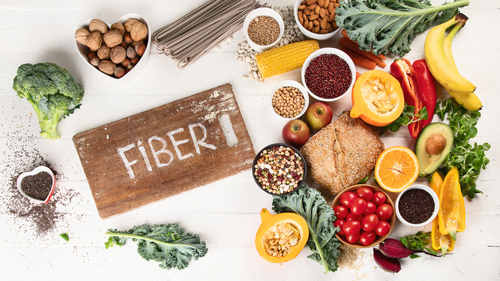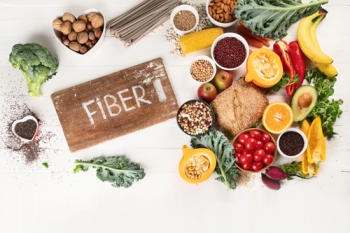 Fiber is a carbohydrate that your body does not digest or absorb. Fiber is also often known as roughage and is found in plant foods. Some of the benefits of fiber include its ability to fill you up quicker, lower cholesterol, keep you full longer, help maintain a healthy weight or aid in weight loss, promote bowel movement regularity, balance blood sugar levels and can help lower your risk of developing heart disease and some cancers.
Fiber is a carbohydrate that your body does not digest or absorb. Fiber is also often known as roughage and is found in plant foods. Some of the benefits of fiber include its ability to fill you up quicker, lower cholesterol, keep you full longer, help maintain a healthy weight or aid in weight loss, promote bowel movement regularity, balance blood sugar levels and can help lower your risk of developing heart disease and some cancers.
Types of fiber: There are two types of fiber, soluble fiber and insoluble fiber. Soluble fiber breaks down in water and insoluble fiber does not. Because soluble fiber breaks down in water, it creates a gel-like substance and can make bowel movements easier to pass. Insoluble fiber promotes bulk in the stool because it does not break down. Plant foods typically have a combination of both soluble and insoluble fiber.
Net carbs: Fiber is included in the total carb count on a food label because it is a carbohydrate. Our bodies don’t absorb the carbohydrates from the fiber so it can be deducted from the total because it will pass through our bodies.
Recommendations: It is recommended that women should aim for 25 grams of fiber daily, and 38 grams daily for men. The rule of thumb is ~14 grams for every 1,000 calories so if you are following a low calorie post-surgical diet 14 grams may be a more appropriate goal. At your next nutrition appointment be sure to discuss fiber with the dietitian.
Sources: As mentioned above, fiber is naturally found in plant foods. Some foods are higher in fiber than others. When you make higher fiber swaps in your diet, it can make a big difference in your overall health. Instead of white rice, try cauliflower rice. Instead of white bread, try a whole wheat bread. Here are some examples of other foods high in fiber:
- 1 large pear with skin (7 grams)
- 1 cup fresh raspberries (8 grams)
- ½ medium avocado (5 grams)
- 1 ounce almonds (3.5 grams)
- ½ cup cooked black beans (7.5 grams)
- 1 cup cooked pearled barley (6 grams)
When adding fiber to your diet it is important for it to be introduced gradually and to be accompanied by an increase of fluids. The addition of fluids will make sure the fiber has an adequate amount of fluid needed to pass through smoothly as it can act as a sponge, soaking up fluid in your digestive tract.
Written by: Gigi Ravenhall, RDN
Gigi Ravenhall is a Registered Dietitian at Long Island Laparoscopic Surgery focusing on pre and post-operative nutritional education and counseling. Gigi most enjoys the aspect of her work where she gets to know people on an individual basis to provide personalized support.









